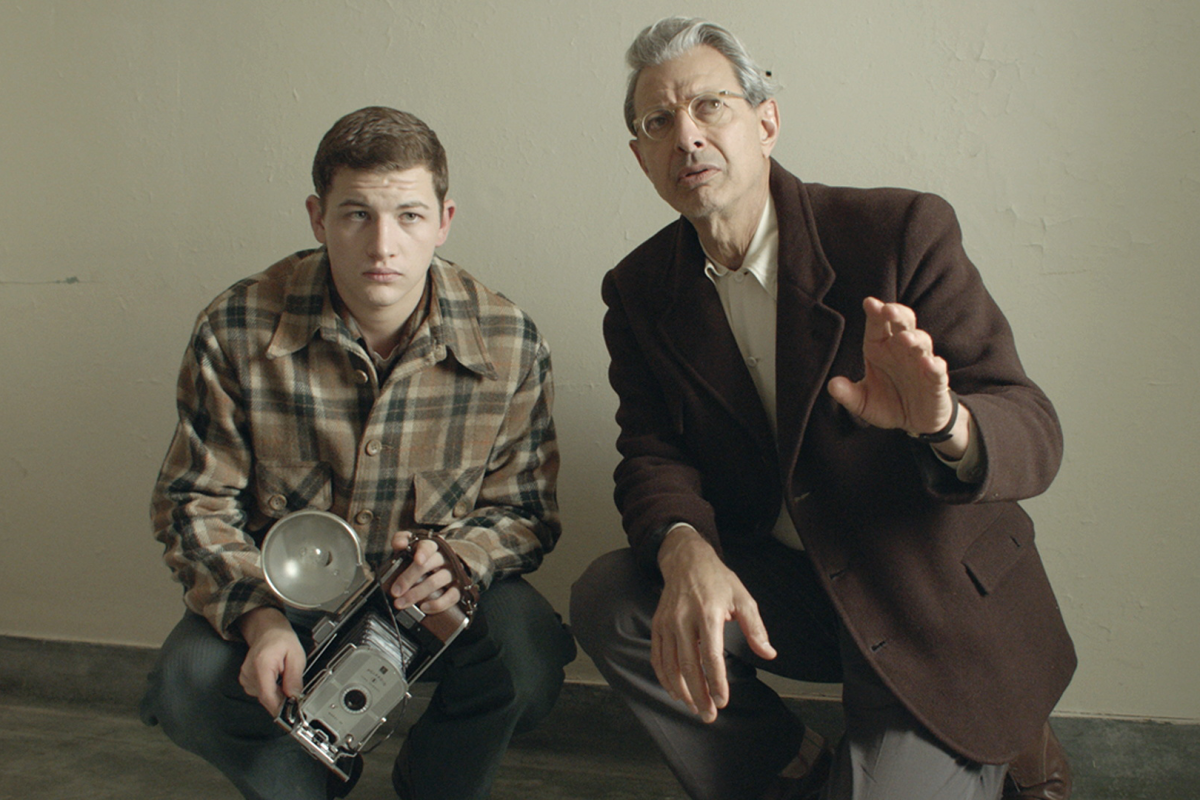“A dime a dozen, gas station dreams!” These words, howled during a drunken tirade by the French acting great Denis Lavant as a quack healer whose methods involve mesmerizing marimba music and spastic dancing, come closest to encapsulating the thesis statement of Rick Alverson’s new film, The Mountain. The enigmatic, 1950s-set drama completes an informal trilogy of perspectives on America, continuing a despairing national critique running through his last two features, Entertainment and The Comedy. Lavant’s character sees the United States as a ghastly, garish place with a dangerously rose-tinted impression of its own chintzy soullessness. In the room, an artificially prettified hanging picture of a natural vista lends the film its title and provides a canny symbol for our country’s tendency to take a romanticized view of itself. Ceci nes pas une montagne, et cetera.
Speaking with InsideHook at a sunlit office in Midtown Manhattan, Alverson makes specific mention of his choice to bookend the film with immigrants. Lavant delivers a showstopping performance near the tail end of the run time, and the first act begins with a brief appearance from living German legend Udo Kier as a figure-skating instructor and father to our protagonist Andy (Tye Sheridan). The director believes that European directors have historically made the most clear-eyed movies about America, that it takes some distance to really see something clearly. He’s adopted this philosophy in his own work, but as a dyed-in-the-wool American boy (he spent his younger years in Wyoming, and currently leads a decidedly un-Hollywood lifestyle in his modest Virginia home), he’s had to blaze his own path to the outskirts. In summiting The Mountain, Alverson gets there, estranging himself from the familiar and rational to get a bird’s-eye glimpse of his homeland’s ugly true face.
“The problem with narrative is that it might be an outmoded delivery device for meaning and message and all the other things we thought it might be a perfect envelope for,” Alverson explains, speaking in dense professorial paragraphs that an interviewer wishes he could read two or three times instead of listen to. “We’ve watched this thing go off the rails and get manipulated and abused and hijacked, narrative as a delivery device. It’s in media, politics, and especially cinema.”
He takes a moment, considers what he’s said, and clarifies. “Take A Woman Under the Influence, that’s a great example of a film in which the narrative fractures and continues to fracture. It’s almost not functional; frankly, it’s a fucking mess. It lets the narrative break as the family does, a beautiful coherence between form and content.”

Alverson makes fucking messes — his words! — in the Cassavetean sense, films that elude simple interpretation in an effort to disorient the viewer. The plot starts out coherent and gradually grows thinner as Alverson traffics more and more in sensation, imagery and thematic suggestion. The film opens with Sheridan’s Andy losing his father, and coping with his new status as a young-adult orphan by agreeing to accompany doctor Wallace Fiennes (Jeff Goldblum) on the medical demonstration circuit. Because he’s showing off a barbaric frontal lobotomy procedure controversial even then, the ensuing road movie takes them both on a tour through the dark outer limits of the human psyche. As they go around the countryside doing this frightful work, Andy slowly wakes up to the moral defects of their cause, and the film’s internal reason breaks down in tandem with its characters’ flagging sanity.
In the shadowy history of the lobotomy procedure, Alverson found a direct conduit for his ideas about the larger existential rot of the era.“There’s a normative element to [the lobotomy], in the surface conformity,” he theorizes. “What interests me is that it’s a very male procedure, stifling the un-orderly and the prickly, all emotional non-conformity. The people who received the procedure had been diagnosed as schizophrenics as a blanket diagnosis. In fact, they were homosexuals, quote-unquote ‘promiscuous’ young women, women going through menopause — lots of things outside of the realm of mental illness. The idea of forcing an individual into conformity by putting them in a passive state, that fascinated me, the act of stifling.”
While well-paid screenwriters gnaw their pencils figuring out if their first act is too long or the pacing has started to lag, Alverson begins with his personal theoretical interests and determines form by working backward. The Mountain resists the rhythms and habits of popular cinema to keep the audience offguard, willfully zagging wherever a viewer has been conditioned to expect a zig. As opposed to the vibrant, nostalgia-stirring Technicolor hues associated with the midcentury era, Alverson shoots in washed-out beiges and greys that drain the life from each gorgeous but sterile composition. “Films make an approximation of their time period,” he says. “If a person goes to see a film set in the past and thinks, ‘I have access to the time, that’s what it was really like,’ that’s a dangerous idea. I stage the hospital scenes like wax museums, large, still tableaux. These scenes move like a slideshow. They look for narrative.”
As part of his alienation offensive, Alverson also drops the loose, improvisational style of The Comedy and Entertainment to adopt a hyper-controlled alternative of performance; he’d discuss the subtext of each scene with his actors, and then give them specific physical direction. (“I’m telling them to part their lips, lower their eyelids, step three-quarters of an inch to the left, tilt your shoulders this way.”) To rewrite the read on the ‘50s, unearthing the morass of repressed anxiety that posterity has repainted as the good ol’ days, the filmmaker had to first destabilize himself, then his cast, and finally, his audience.
“When you’re making films, sometimes the medium perforates the closed circle of your universe,” Alverson says, his metaphors cloaking the artist’s age-old impetus to challenge themselves along with their audience. “Increasingly, these circles are more closed than they ever have been, because we’re surrounded by a hall of mirrors of our own making — comfort, validation. For me, the idea that the ‘50s were anything but a time of grand suppression and white male suburban dominance, we pull the curtain back on that. We see in Trump’s slogans a grandiose romanticizing of the era. He doesn’t usually say so, but he’s referring to the ‘50s.”
There’s an element of the Trumpian in Dr. Fiennes, a vain charlatan skilled at talking his way around his own fraudulence. But if that seems like a dig at our sitting Commander-in-Chief, that’s just because Alverson has hit on something eternal. He contends that this strain of bullying, predatory egotism has defined every chapter of American history, like the monster hiding in the closet of our national psychology. He name-drops the Wizard of Oz (the character, not the film) as an inspiration for how he conveys “belief fractured by actuality,” the ruler of the Emerald City being a fantastical take on the “frauds and hucksters that have defined this nation, and still define it.” That concept of cold reality bleeding through to stain our precious self-delusions is at the heart of Alverson’s technique, the end goal of his distrust for the seductive deceptions of the cinema.
When you’re making films, sometimes the medium perforates the closed circle of your universe.
“I want us to move past the threshold of the film and become aware of its materiality,” Alverson says, letting the words hang in the air a moment. “All of my films are positioned around the fallacy of arrival. Narrative, with its arcs and resolution, tells us we arrive places. It isn’t a condition of living, though, and that always bothered me. My favorite films all end open and unresolved.” He describes The Mountain as “an attack on the problem of clarity,” denouncing the “compact and digestible and disposable.” He finds it “disappointing” when reviews attempt to wrestle his films into order instead of accepting the mystery and uncertainty as an endpoint unto itself. About his film’s stubborn refusal to cast Dr. Fiennes as an out-and-out monster or a wounded victim of circumstance, he says, “It’s irresponsible to cast moral judgement, because it lets the audience off the hook. I wanted us to stay culpable.”
In the uppermost echelons of the film industry, creatives and executives squabble about how much to hold a viewer’s hand, either through linear, motivation-based plotting that aids comprehension or “relatable” characters who provide a foothold for empathy. Every creative choice Alverson makes is guided by the opposite impulse, to get as far from our shared comfort zone as possible. Many films claim the United States and the fundamentals of its identity as their topic, with every new year bringing a few more movies with titles along the lines of American [Noun]. They tend to conclude with the tidy pearls of wisdom that Alverson despises, offering insights about capitalism or media saturation, what-have-you. He would rather leave more doubt behind than he came with, finding honesty only in the concession that a place as gnarled, complicated and contradictory as America cannot possibly be understood. He sees through the disillusioned eyes of a foreigner — not of territory but of ideology — a stranger in a strange land.
This article appeared in an InsideHook newsletter. Sign up for free to get more on travel, wellness, style, drinking, and culture.


















